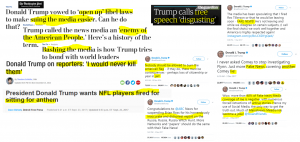Trending
Opinion: How will Project 2025 impact game developers?
The Heritage Foundation's manifesto for the possible next administration could do great harm to many, including large portions of the game development community.
This year I gave a presentation on video games and the First Amendment at Casual Connect USA. This is Part 1: Introduction and Background. Parts 2-3, coming very soon, will cover the basics of what the First Amendment says, and what it protects.

This year I gave a presentation on video games and the First Amendment at Casual Connect USA. It focused on the importance of pushing boundaries and resilience in the face of adversity. You can see the entire presentation, here:
I tried to cover a lot of material in 20 minutes. I didn’t cover everything, though.
Casual Connect ended on January 18. I originally penned this on March 3. In the time between, there were 24 mass shootings in the United States. 54 people have been killed because of gun violence. 103 injured. This includes 17 people killed during a mass shooting at a high school in Parkland, Florida.
The Parkland shooting has led to renewed calls for regulation of violent video games.
These calls, of course, come despite ample evidence that video games are not the heart of the problem. And lots of alternative avenues for regulation that could actually lead to change.
President Trump has already made clear his hostility toward the media and the First Amendment.

All of this is just background and context for why I am going to spend a series of posts and a series of speaking engagements talking about this. The video game industry can make for a convenient scapegoat: some games are really violent and kids often play them. But video games are also, in my opinion, one of the highest forms of artistic expression we have available. A combination of visual art, sound composition and storytelling akin to film, but with the added interactivity and technical achievement setting it apart from all others.
Scapegoating video games won’t solve the gun violence problem, but it could lead to limitations and regulations on the industry. It could put economic pressure on retailers, developers, publishers and distributors. It could stifle creativity and expression. It could hinder free speech.
This is Part 1: Introduction and Background. Parts 2-3, coming very soon, will cover the basics of what the First Amendment says, and what it protects.
Later posts will cover what the First Amendment does not protect, the appropriate role of private regulatory bodies like PEGI and the ESRB, some interesting stories of bans and regulation and, finally, some examples of games that highlight the expression that the medium is capable of.
Read more about:
BlogsYou May Also Like